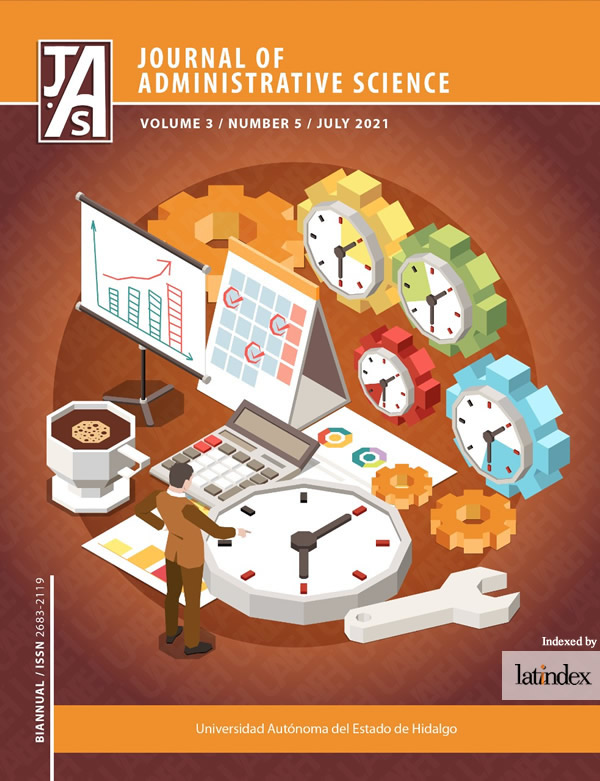Social Entrepreneurship in Higher Technology Education Students: Gender Analysis
DOI:
https://doi.org/10.29057/jas.v3i5.6768Keywords:
Entrepreneurship social, Students, GenderAbstract
The topic of social entrepreneurship is of great importance due to the diverse problems that society faces, which require the development of effective projects with a social conscience that is oriented to contribute to community well-being. The aim of this research was to analyse the social entrepreneurial intentions of students from the business area in a higher education institution, with the purpose of identifying significant differences regarding gender. The study is empirical, descriptive, and exploratory, using a quantitative approach. The sample consisted of 228 students, of which 45.61% are male and 54.39% are female. The statistical method was applied through the t-student test, which allows us to accept the hypothesis that there is a significant difference in the social entrepreneurial intentions between men and women.
Downloads
Publication Facts
Reviewer profiles N/A
Author statements
Indexed in
- Academic society
- N/A
- Publisher
- Universidad Autónoma del Estado de Hidalgo
References
UNESCO (2009). Organización de las Naciones Unidas para la Educación, la Ciencia y la Cultura (UNESCO). World Conference on Higher Education: The New Dynamics of Higher Education and Research for Societal Change and Development. Recuperado de http://unesdoc.unesco.org/images/0018/001832/183277e.pdf
Guzmán, J. y Rodríguez, M.J. (2008). Comportamiento de las mujeres empresarias: una visión global. Revista de Economía Mundial, 18, 381-392.
Organización para la Cooperación y el Desarrollo Económicos (OECD) (2019). Resultados y relevancia para el mercado laboral, 2019. Recuperado de: https://www.oecd.org/centrodemexico/medios/educacion_superior_en_mexico.pdf
Borrayo, C.L., Valdez, A. y Delgado, B. (2019). Cultura emprendedora en jóvenes universitarios de Guadalajara, México. Revista de Ciencias Sociales, 25(3), 72-87. doi: 10.31876/rcs.v26i3
Encuesta Nacional de Empleo (ENOE) (2016). Encuesta Nacio4nal de Empleo y Ocupación (ENOE). Recuperado de: https://www.inegi.org.mx/temas/empleo/
Santos, F. J., Barroso, M. y Guzmán, C. (2013). La economía global y los emprendimientos sociales. Revista de Economía Mundial, 35, 177-196.
Castelao, M.E. (2016). Las políticas públicas y su visión de la economía social y solidaria en Argentina. Revista Mexicana de Ciencias Políticas y Sociales, 61(227), 349-378. doi: 10.1016/S0185-1918(16)30032-0
Korsgaard, S. (2011). Opportunity formation in social entrepreneurship. Journal of Enterprising Communities: People and places in the global economy, 5 (4), 265- 285.
Pache, A.C. y Chowdhury, I. (2012). Social entrepreneurs as institutionally embedded entrepreneurs: Toward a new model of social entrepreneurship education. Academy of Management Learning & Education, 11(3) 494-510.
Sánchez, J.C. (2013). The impact of an Entrepreneurship Education Program on entrepreneurial competencies and Intention. Journal of Small Business Management, 51(3), 447-465.
Welsh, D. H. B. y Krueger, N. (2012) The evolution of social entrepreneurship: what have we learned? Journal of Technology Management in China, 7(3), 270-290.
Moreau, C. y Mertens, S. (2013) Managers’ competences in social enterprises: which specificities? Social Enterprise Journal, 9 (2), 164-183.
Shane, S. (2000). Prior knowledge and the discovery of entrepreneurial opportunities Organization Science, 11 (4), 448-469.
Thompson, J., Alvy, G., y Lees, A. (2000). Social entrepreneurship - a new look at the people and the potential. Management Decision, 38(5), 328-338.
Melián, A. (2011). Las empresas se inserción sociolaboral creadas por emprendedores sociales. Un análisis Delphi. En: Sanchis, J.R. (dir.). Emprendimiento, Economía Social y Empleo. Ed. IUDESCOOP. Emprendimiento social y empresas de inserción.
Melián, A., Campos, V. y Sanchis, J. R. (2011). Emprendimiento social y empresas de inserción en España. Aplicación del método DELPHI para la determinación del perfil emprendedor y las empresas sociales creadas por emprendedores. REVESCO, 106, 150-172.
Fournier, A. N. (2011). Emprendimiento social. Documentos de investigación. Administración de Empresas, 6, Ediciones Fundación Universidad.
Becerra, M. E., Cortés, E. M., Malacara, A. R. y Alegría, N. L. (2014). Factores detonadores del Emprendimiento Social, base para el análisis de casos de éxito. International Review of Business Research Papers, 10(3), 134- 156.
Moreira, P. y Urriolagoitia, L. (2011). El emprendimiento social. Revista Española del Tercer Sector, 17, 17-40.
Moreno, K. (2017). La apuesta de México al emprendimiento social: Hult Prize, el “Premio Nobel de los estudiantes. Muuch’ xíimbal. 139-154.
Rodríguez Gómez, C. G. (2016). Panorama de programas académicos y espacios de emprendimiento en algunas universidades de México en relación con el sector de la economía social. (Tesis inédita de maestría). Universidad Iberoamericana de Puebla.
Amador, M. L., García, Y. y Gutiérrez, G. (2019). Intención emprendedora de estudiantes respecto al género de un tecnológico en Hidalgo, México. Revista Iberoamericana de Ciencias, 6(4), 20-34.
Espino, A. 2005. Un Marco de Análisis para el Fomento de las Políticas de Desarrollo Productivo con Enfoque de Género. Santiago de Chile: CEPAL.
DeTienne D.R. y Chandler, G.N. (2007). The Role of Gender in Opportunity Identification, Entrepreneurship Theory and Practice, 31(3), 365-386. doi: 10.1111/j.1540-6520.2007.00178.x

















